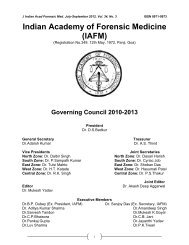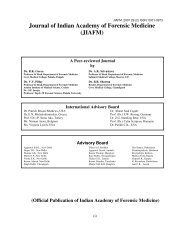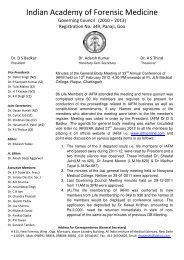Indian Academy of Forensic Medicine (IAFM) - Official website of IAFM
Indian Academy of Forensic Medicine (IAFM) - Official website of IAFM
Indian Academy of Forensic Medicine (IAFM) - Official website of IAFM
Create successful ePaper yourself
Turn your PDF publications into a flip-book with our unique Google optimized e-Paper software.
J <strong>Indian</strong> Acad <strong>Forensic</strong> Med. Jan- March 2012, Vol. 34, No. 1 ISSN 0971-0973<br />
Original Research Paper<br />
Determination <strong>of</strong> Sex by Sciatic Notch/Acetabular Ratio<br />
(Kelley’s Index) in <strong>Indian</strong> Bengali Skeletal Remains<br />
*Partha Pratim Mukhopadhyay<br />
Abstract<br />
Kelley used the sciatic notch is to acetabular ratio as the osteometric method to differentiate<br />
between male and female hipbones. The present study was designed to examine the applicability <strong>of</strong> this<br />
index (sciatic notch /acetabular height ratio) and the rule <strong>of</strong> thumb (<strong>of</strong> Kelley) in <strong>Indian</strong> Bengali skeletal<br />
remains. A preliminary attempt was made to derive a sectioning point and propose a new “rule <strong>of</strong> thumb”<br />
approach for determining sex from skeletal remains.<br />
The study showed that bones with sciatic notch /acetabular height index equal or greater than .93<br />
(or 93 when expressed as a percentage) was definitely female and those with values less than .93 were<br />
male. The results <strong>of</strong> applying this new rule on the present series <strong>of</strong> <strong>Indian</strong> Bengali hipbones indicate that<br />
93.3 % <strong>of</strong> the total sample could be correctly classified in to the proper sex. Of those 92.8% <strong>of</strong> the males<br />
and 93.75% <strong>of</strong> the females were correctly classified by the new rule. The present new rule <strong>of</strong> thumb<br />
approach is a valid, effective, reliable, population specific and easy method to differentiate between male<br />
and female pelvis in <strong>Indian</strong> Bengali skeletal remains<br />
Key Words: <strong>Forensic</strong> anthropology, sex determination, hipbone, Kelley’s index, <strong>Indian</strong> Bengali<br />
Introduction:<br />
Sexual dimorphism <strong>of</strong> the human<br />
hipbone has been extensively researched,<br />
reviewed and published in forensic as well as<br />
anthropological literature. [1] Earlier works on<br />
sexing <strong>of</strong> the innominate were based on<br />
morphological features. [2] Subsequently<br />
researchers adopted osteometric methods to<br />
quantitatively differentiate between male and<br />
female hipbones. Primarily those objective<br />
methods were based on (a) osteometry (b)<br />
derivation <strong>of</strong> indices or ratios (c) linear<br />
discriminate function analysis. All <strong>of</strong> these<br />
methods in essence were population specific. [3,<br />
4]<br />
The indices /ratios were effectively used<br />
to determine sex <strong>of</strong> skeletal remains only when<br />
they belonged to one major racial group. [5] In<br />
1979, Kelley [6] used the sciatic notch is to<br />
acetabular index to differentiate between male<br />
and female hipbones. It was proposed to<br />
overcome the limitations posed by the racial<br />
difference in osteometry.<br />
Corresponding Author:<br />
*Pr<strong>of</strong>essor and Head<br />
Department <strong>of</strong> <strong>Forensic</strong> & State <strong>Medicine</strong><br />
Calcutta National Medical College<br />
Kolkata –14, West Bengal<br />
E-mail: drpartha99md@gmail.com<br />
27<br />
Kelley while working on an American<br />
sample showed that 90% <strong>of</strong> the adult skeletal<br />
remains could be correctly classified in the<br />
proper sex. Kelley suggested a useful “rule <strong>of</strong><br />
thumb” approach whereby innominate with an<br />
index <strong>of</strong> more than 88 were classified as female<br />
and those 86 or less as male.<br />
Kelley’s index (rule <strong>of</strong> thumb approach)<br />
however had low discriminatory capacity for both<br />
English and Dutch sample. [7] The investigators<br />
showed that the index was an efficient indicator<br />
<strong>of</strong> male pelvis but it proved little better than<br />
chance at correctly determining sex in the<br />
female pelvis.<br />
The present study was designed to<br />
examine the applicability <strong>of</strong> the index (sciatic<br />
notch /acetabular height ratio) and its rule <strong>of</strong><br />
thumb (<strong>of</strong> Kelley) in <strong>Indian</strong> Bengali skeletal<br />
remains. Also a preliminary attempt was made<br />
to derive a sectioning point and propose a new<br />
“rule <strong>of</strong> thumb” approach for determining sex<br />
from skeletal remains (hip bone) in <strong>Indian</strong><br />
Bengali population.<br />
Materials and Methods:<br />
A study was conducted at the<br />
department <strong>of</strong> <strong>Forensic</strong> <strong>Medicine</strong>, Calcutta<br />
National Medical College, Kolkata, West Bengal,<br />
India. The sample comprised <strong>of</strong> 30 adult fully<br />
ossified innominate bones from the museum<br />
collection <strong>of</strong> the department. The bones with<br />
documented sex belonged to the population <strong>of</strong>









